🎵 Tracklist:
Track 1: The Ecstacy of Gold
Track 2: Enter Sandman
Track 3: Creeping Death
Track 4: Harvester of Sorrow
Track 5: Fade to Black
Track 6: Sad but True
Track 7: Master of Puppets
Track 8: Seek and Destroy
Track 9: For Whom the Bell Tolls
Track 10: One
🎸 Album Review:
Metallica’s self-titled album, commonly known as “The Black Album,” released in 1991, marked a significant turning point for the band. Known for their thrash metal roots, Metallica shifted towards a more mainstream sound on this record, incorporating elements of heavy metal, hard rock, and even some balladry. The album’s production, helmed by Bob Rock, was notably more polished and radio-friendly compared to their previous works. Despite the initial backlash from some of their hardcore fans, “The Black Album” went on to become one of Metallica’s most commercially successful albums, solidifying their status as one of the biggest bands in the world.
The album kicks off with “The Ecstasy of Gold,” an instrumental piece that sets the tone with its grandiose orchestration, building anticipation for what’s to come. The iconic opening riff of “Enter Sandman” follows, instantly recognizable to rock fans worldwide. This track encapsulates Metallica’s ability to craft heavy, yet accessible songs, with its infectious chorus and powerful guitar work.
“Creeping Death” and “Harvester of Sorrow” showcase the band’s signature aggression and intensity, with blistering riffs and relentless drumming. These tracks harken back to Metallica’s thrash metal roots, reminding listeners of the band’s formidable musical prowess.
One of the standout moments on the album is “Fade to Black,” a haunting ballad that showcases a more introspective side of the band. The juxtaposition of tender melodies and explosive guitar solos creates a dynamic listening experience, showcasing Metallica’s versatility as songwriters.
“Sad but True” and “Master of Puppets” demonstrate Metallica’s ability to craft heavy, groove-oriented tracks that pack a punch. The crushing riffs and powerhouse vocals in these songs command attention, showcasing the band’s mastery of the genre.
“Seek and Destroy” and “For Whom the Bell Tolls” are live staples that continue to captivate audiences with their infectious energy and anthemic choruses. These tracks highlight Metallica’s ability to create timeless classics that resonate with fans across generations.
The album reaches its climax with “One,” a sprawling epic that combines intricate storytelling with powerful instrumentation. The song’s evocative lyrics and searing guitar work culminate in a breathtaking crescendo, solidifying its status as a fan favorite and a defining moment in Metallica’s discography.
Compared to Metallica’s earlier albums, “The Black Album” represents a departure in sound and approach. While their previous works were characterized by breakneck speed and ferocious energy, this album sees the band embracing a more restrained and melodic style. The production values are noticeably higher, with a focus on cleaner tones and a more polished sound overall.
Despite the shift towards a more commercial sound, “The Black Album” retains the raw intensity and musical complexity that are hallmarks of Metallica’s music. The band’s songwriting prowess is on full display here, with each track offering a unique blend of aggression, melody, and emotion.
Overall, “The Black Album” is a landmark release that catapulted Metallica to mainstream success while still retaining their core sound and identity. It showcases the band’s evolution and willingness to push boundaries, setting the stage for their continued dominance in the rock and metal scene.
In conclusion, Metallica’s self-titled album, “The Black Album,” is a timeless classic that has stood the test of time and continues to resonate with audiences worldwide. With its diverse range of tracks, powerful performances, and impeccable production, this album remains a defining moment in Metallica’s illustrious career, cementing their status as one of the greatest rock bands of all time.
